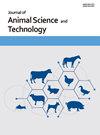瘤胃接种供体三个生长阶段饲粮对体外瘤胃发酵和微生物组的影响
IF 3.2
3区 农林科学
Q1 AGRICULTURE, DAIRY & ANIMAL SCIENCE
引用次数: 0
摘要
韩宇牛和济州黑牛(济州黑牛)是韩国牛的本土品种。据悉,济州黑牛是公认的天然纪念物,生长速度比韩牛慢。虽然有几项研究分析了这些牛的遗传特征,但对它们微生物组差异的研究有限。本研究选用3头韩羽阉牛和3头济州黑阉牛的瘤胃液,并采用生长、早期育肥和后期育肥3种不同饲粮(全混合饲粮[TMRs])为底物,在体外/斜体/斜体/斜体;发酵。<italic>in vitro</italic>按照2 × 3因子排列,孵育3小时和24小时。两个孵育期结束后,分析发酵特性,采用16S rRNA基因测序,采用QIIME2和PICRUSt2进行瘤胃微生物组分析。结果显示,由于接种量效应,瘤胃微生物群存在显著差异。在门水平上,济州黑接种组中发现了Patescibacteria和Synergistota的富集。此外,使用不同的接种剂也影响了主要类群的相对丰度,包括Ruminococcus、Pseudoramibacter、Ruminococcaceae CAG-352和[Eubacterium] ruminantium组。这些由接种物引起的微生物差异可能源于两个供体动物亚种之间不同程度的驯化,这主要影响了早期孵化阶段的发酵和微生物组特征,尽管这只是部分抵消。此外,微生物酶(其中一些参与次级代谢物、脂肪酸和α淀粉酶的生物合成)的预测委托数量因接种量效应而异。然而,这些差异可能只占整个代谢途径的一小部分。相反,研究发现日粮会影响蛋白质生物合成及其相关代谢,这在生长日粮中表现出不同的丰度,并可能与生长期间肉牛的生长促进作用有关。综上所述,本研究表明,使用不同的疫苗对体外<italic> /italic>发酵特性和微生物组特征,主要在孵育早期阶段,有些影响持续到孵育24小时。本文章由计算机程序翻译,如有差异,请以英文原文为准。
Effects of diets for three growing stages by rumen inocula donors on in vitro rumen fermentation and microbiome
Hanwoo and Jeju Black cattle (Jeju Black) are native breeds of Korean cattle. Jeju Black cattle are recognized as natural monuments and are known to exhibit slower growth rates compared to Hanwoo. While several studies have analyzed the genetic characteristics of these cattle, there has been limited research on the differences in their microbiome. In this study, rumen fluid was obtained from three Hanwoo steers and three Jeju Black steers, and three different diets (total mixed rations [TMRs] for growing, early fattening, and late fattening periods) were used as substrates for in vitro fermentation. The in vitro incubation was conducted for 3 h and 24 h following a 2 × 3 factorial arrangement. After both incubation periods, fermentation characteristics were analyzed, and ruminal microbiome analysis was performed using 16S rRNA gene sequencing, employing both QIIME2 and PICRUSt2. The results revealed significant differences in the ruminal microbiota due to the inoculum effect. At the phylum level, Patescibacteria and Synergistota were found to be enriched in the Jeju Black inoculum-treated group. Additionally, using different inocula also affected the relative abundance of major taxa, including Ruminococcus, Pseudoramibacter, Ruminococcaceae CAG-352, and the [Eubacterium] ruminantium group. These microbial differences induced by the inoculum may have originated from varying levels of domestication between the two subspecies of donor animals, which mainly influenced the fermentation and microbiome features in the early incubation stages, although this was only partially offset afterward. Furthermore, predicted commission numbers of microbial enzymes, some of which are involved in the biosynthesis of secondary metabolites, fatty acids, and alpha amylase, differed based on the inoculum effect. However, these differences may account for only a small proportion of the overall metabolic pathway. Conversely, diets were found to affect protein biosynthesis and its related metabolism, which showed differential abundance in the growing diet and were potentially linked to the growth-promoting effects in beef cattle during the growing period. In conclusion, this study demonstrated that using different inocula significantly affected in vitro fermentation characteristics and microbiome features, mainly in the early stages of incubation, with some effects persisting up to 24 h of incubation.
求助全文
通过发布文献求助,成功后即可免费获取论文全文。
去求助
来源期刊

Journal of Animal Science and Technology
Agricultural and Biological Sciences-Food Science
CiteScore
4.50
自引率
8.70%
发文量
96
审稿时长
7 weeks
期刊介绍:
Journal of Animal Science and Technology (J. Anim. Sci. Technol. or JAST) is a peer-reviewed, open access journal publishing original research, review articles and notes in all fields of animal science.
Topics covered by the journal include: genetics and breeding, physiology, nutrition of monogastric animals, nutrition of ruminants, animal products (milk, meat, eggs and their by-products) and their processing, grasslands and roughages, livestock environment, animal biotechnology, animal behavior and welfare.
Articles generally report research involving beef cattle, dairy cattle, pigs, companion animals, goats, horses, and sheep. However, studies involving other farm animals, aquatic and wildlife species, and laboratory animal species that address fundamental questions related to livestock and companion animal biology will also be considered for publication.
The Journal of Animal Science and Technology (J. Anim. Technol. or JAST) has been the official journal of The Korean Society of Animal Science and Technology (KSAST) since 2000, formerly known as The Korean Journal of Animal Sciences (launched in 1956).
 求助内容:
求助内容: 应助结果提醒方式:
应助结果提醒方式:


